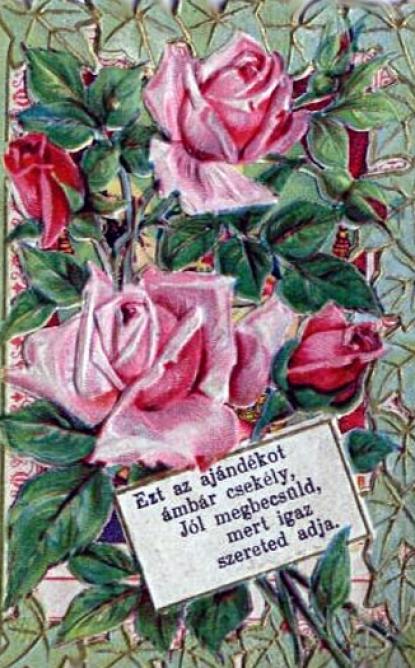2025. April 27. Sunday
Tragor Ignác Múzeum - Greek Church Exhibition Space - Vác
|
|
Address: 2600, Vác Március 15. tér 19.
Phone number: (27) 500-750
E-mail: tragormuzeum.vac@gmail.com
Opening hours: Wed-Thu 10-17, Fri-Sun 10-18
|
The exhibition has closed for visitors.
2004.06.11. - 2004.09.26.
Museum tickets, service costs:
|
Ticket for adults
|
600 HUF
|
/ capita
|
|
Ticket for students
|
300 HUF
|
/ capita
|
|
Ticket for pensioners
|
300 HUF
|
/ capita
|
|
Group guide
(up to 35 people)
|
6000 HUF
|
|
|
Group guide for students
(up to 35 people)
|
3000 HUF
|
|
|
Group guide
(up to 35 people)
|
9000 HUF
|
The rose as the queen of flowers is one of the most complex motif.

As far as we know the first person to bring roses to the country was King Sarrikin of Sumer 5600 years ago. According to an ancient Hindi myth Brahma had believed that the lotus flower was the most royal representative flower when Visnu showed him a rose. Then Brahma had to admit that Visnu was right, the rose is more royal. Laksmí, the beautiful Goddess of love was born of a rose too. Its Greek counterpart Aphrodite stepped in a rose thorn when searching for Adonis and the rose that was born of her blood was the flower of love that could win over death. In the belief system of the Romans the rose was born of the tears of Venus. Off course since love is as ephemeral as the life of a rose, this flower became the symbol of death as well.
The rose is the flower of the field of Elysium. In Christian symbolism it is the symbol of being chosen by God, martyrdom, and the triumph over death. When depicted, it usually has five petals. The rosary originally made of pressed rose petals refer to three times five episodes of the life of the Virgin Mary: five happy, five sad, and five triumphant episodes. In Christianity the rose is attributed to Virgin Mary. She is the 'rose without thorns', since according to the legend roses only received thorns after the original sin. The famous representations showing Mary with roses originate from this idea.
The light that shine through the so called 'rose windows' of the Gothic cathedrals may seem like or feel like the same light as Dante wrote about in the last part of his work: 'Divine Comedy'. Dante perceives a large rose in Paradise. Its petals are real souls; the highest one is the Mother of God herself.
According to the above stated information it is not surprising that the rose is one of the most frequently used elements of coats of arms. It is worth remembering the white and red roses of the Lancaster and York families known by Shakespeare, which are the flowers of life and death.
The rose motif often appears in the Hungarian vernacular art as well. It is the symbol of love and the will to live. In our folk songs the lines that tell about tearing down a rose always mean the loosing of virginity for a girl. Here again blood and love are represented together in the picture of a flower.
György Szemadám

As far as we know the first person to bring roses to the country was King Sarrikin of Sumer 5600 years ago. According to an ancient Hindi myth Brahma had believed that the lotus flower was the most royal representative flower when Visnu showed him a rose. Then Brahma had to admit that Visnu was right, the rose is more royal. Laksmí, the beautiful Goddess of love was born of a rose too. Its Greek counterpart Aphrodite stepped in a rose thorn when searching for Adonis and the rose that was born of her blood was the flower of love that could win over death. In the belief system of the Romans the rose was born of the tears of Venus. Off course since love is as ephemeral as the life of a rose, this flower became the symbol of death as well.
The rose is the flower of the field of Elysium. In Christian symbolism it is the symbol of being chosen by God, martyrdom, and the triumph over death. When depicted, it usually has five petals. The rosary originally made of pressed rose petals refer to three times five episodes of the life of the Virgin Mary: five happy, five sad, and five triumphant episodes. In Christianity the rose is attributed to Virgin Mary. She is the 'rose without thorns', since according to the legend roses only received thorns after the original sin. The famous representations showing Mary with roses originate from this idea.
The light that shine through the so called 'rose windows' of the Gothic cathedrals may seem like or feel like the same light as Dante wrote about in the last part of his work: 'Divine Comedy'. Dante perceives a large rose in Paradise. Its petals are real souls; the highest one is the Mother of God herself.
According to the above stated information it is not surprising that the rose is one of the most frequently used elements of coats of arms. It is worth remembering the white and red roses of the Lancaster and York families known by Shakespeare, which are the flowers of life and death.
The rose motif often appears in the Hungarian vernacular art as well. It is the symbol of love and the will to live. In our folk songs the lines that tell about tearing down a rose always mean the loosing of virginity for a girl. Here again blood and love are represented together in the picture of a flower.
György Szemadám
